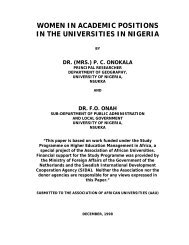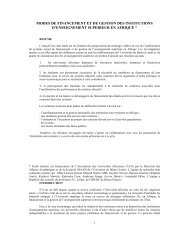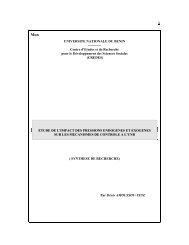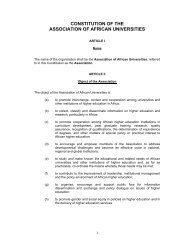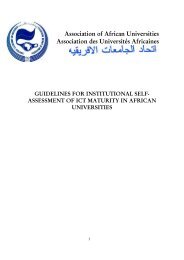undergraduates' attitudes and the study of mathematics at the ...
undergraduates' attitudes and the study of mathematics at the ...
undergraduates' attitudes and the study of mathematics at the ...
- No tags were found...
Create successful ePaper yourself
Turn your PDF publications into a flip-book with our unique Google optimized e-Paper software.
Some studies have shown th<strong>at</strong> girls in single-sex schools performed better than girls in mixed<br />
schools in Nigerian <strong>and</strong> Swazil<strong>and</strong> schools (Lockhead <strong>and</strong> Komenan, 1988; Kaino, 1996).<br />
Though many studies did not investig<strong>at</strong>e factors which affected girls performance in class,<br />
factors such as family influences, traditional <strong>and</strong> school characteristics had a role to play in<br />
influencing girls performance. For example girls had less time to <strong>study</strong> as <strong>the</strong>y were burdened<br />
with household tasks <strong>at</strong> home (than boys) <strong>and</strong> this was likely to lower <strong>the</strong>ir achievement<br />
(Fapohunda 1978, Wrzesinska 1980, <strong>and</strong> Wheldon <strong>and</strong> Smith 1986). School characteristics could<br />
involve for example <strong>the</strong> type <strong>of</strong> school (girls, boys or mixed), sex <strong>of</strong> teachers <strong>and</strong> <strong>the</strong> <strong><strong>at</strong>titudes</strong> <strong>of</strong><br />
both students as well as teachers in learning in <strong>the</strong> school environment. O<strong>the</strong>r school<br />
characteristics could be <strong>the</strong> situ<strong>at</strong>ion where teachers were less likely to encourage girls to pursue<br />
m<strong>at</strong>hs <strong>and</strong> science subjects (Eshiwani 1983) <strong>and</strong> girls' schools where girls were more confident<br />
with better performance than girls in mixed schools (Kaino, 1996).<br />
Gender studies in ma<strong>the</strong>m<strong>at</strong>ics<br />
Many studies on gender differences in <strong>the</strong> <strong>study</strong> <strong>of</strong> m<strong>at</strong>hs have been done in developed countries<br />
than in developing countries. While studies in developed countries have indic<strong>at</strong>ed th<strong>at</strong> gender<br />
differences in ma<strong>the</strong>m<strong>at</strong>ical performance were diminishing in <strong>the</strong>se countries, some o<strong>the</strong>r studies<br />
have come up with contradicting views. The <strong>study</strong> by Hyde et al (1990) showed th<strong>at</strong> for <strong>the</strong> past<br />
30 years gender differences in m<strong>at</strong>hs performance were diminishing in developed countries. This<br />
contention was supported by studies in Canada <strong>and</strong> United St<strong>at</strong>es by Lafortune (1989) <strong>and</strong> Frost<br />
et al (1994) respectively. While Lafortune showed th<strong>at</strong> girls <strong>and</strong> boys performed equally well in<br />
m<strong>at</strong>hs <strong>the</strong> <strong>study</strong> revealed th<strong>at</strong> girls had still some more neg<strong>at</strong>ive <strong>at</strong>titude towards m<strong>at</strong>hs due to<br />
<strong>the</strong>ir gre<strong>at</strong>er anxiety when learning m<strong>at</strong>hs.<br />
5



